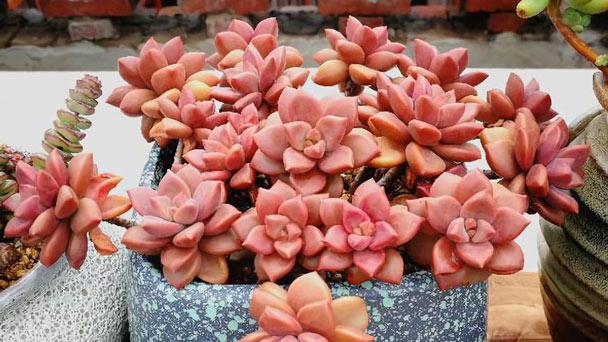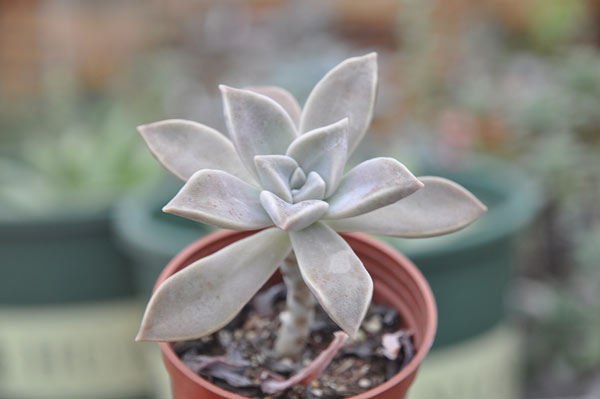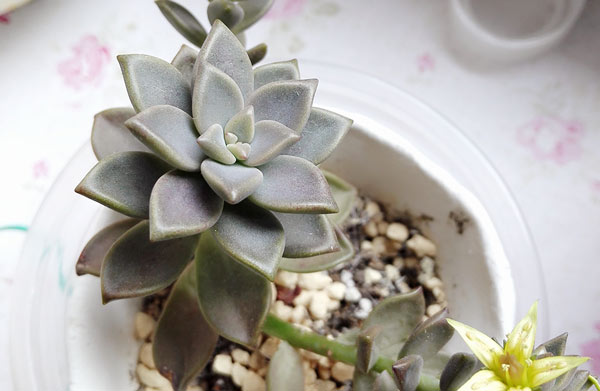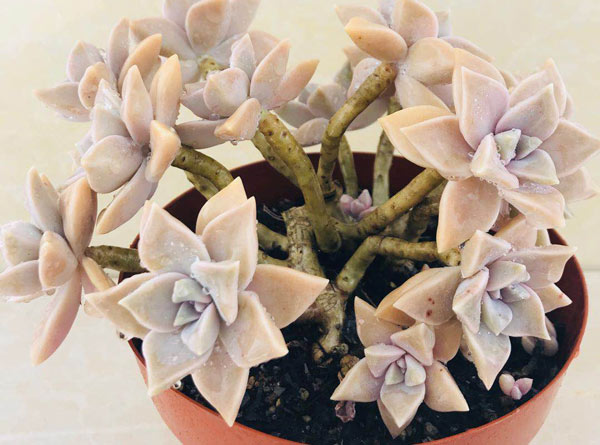Graptopetalum Paraguayense (Ghost Plant) Grow & Care Guide
Written by Iris
Oct 19 2021

Graptopetalum Paraguayense is a beautiful trailing succulent. The plant grows up to 1 foot (30 cm) long. The leaf of Graptopetalum Paraguayense is gray and white, and under hot and dry conditions, it can be extradited to a blue gray if partially shaded.



Unfortunately, the stretched out segment cannot go back to it's compact shape, but you can keep the rest of your Graptopetalum Paraguayense compact if you move the graptopetalum succulent to an area with more sun. If you want to get a compact shape back and do not like the sprawling look, you will have to propagate the cutting, as described above.
Where to Grow Graptopetalum Paraguayense (Ghost Plant)How to Grow Graptopetalum Paraguayense (Ghost Plant)Graptopetalum Paraguayense Propagation with SeedsGraptopetalum Paraguayense Propagation with Stem CuttingsGraptopetalum Paraguayense Propagation with Leaf CuttingsGraptopetalum Paraguayense Propagation with OffsetsHow to Care for Graptopetalum Paraguayense (Ghost Plant)Graptopetalum Paraguayense Lighting RequirementsGraptopetalum Paraguayense Soil CareGraptopetalum Paraguayense WateringGraptopetalum Paraguayense Temperature & Humidity CareGraptopetalum Paraguayense FertilizerGraptopetalum Paraguayense PruningGraptopetalum Paraguayense Pests & Diseases CareGraptopetalum Paraguayense Care FAQIs Graptopetalum Paraguayense Poisonous?Why is my Graptopetalum Paraguayense tall and stretched out?Why are my Graptopetalum Paraguayense leaves falling off?Does Graptopetalum Paraguayense grow indoors or outdoors?How to Distinguish Graptoveria from EcheveriaGraptoveria Blooms Compared to EcheveriaGraptoveria Have Thicker Leaves
Where to Grow Graptopetalum Paraguayense (Ghost Plant)
If you live in a colder environment, where temperature can go below 20 °F (-6.7 °C), You should plant Graptopetalum paraguayense in a pot (better with a drainage hole). Because it is not cold hardy and you'll be able to bring it inside in winter. It grows well in a brighter area where it gets enough direct sunlight.How to Grow Graptopetalum Paraguayense (Ghost Plant)
Graptopetalum Paraguayense Propagation with Seeds
The seeds are sown in pots that are wider than they are tall, with holes for drainage, filled with substrate. Then, it is watered and the seeds are placed on the surface, ensuring that they are not piled up. In this sense, the ideal is always better to put a few in many containers, than many in a few. Finally, they are covered with a thin layer of substrate, or with previously washed river sand, and the seedbeds are placed outside, or in a bright interior near a heat source. They will germinate in an average of 10-15 days.Graptopetalum Paraguayense Propagation with Stem Cuttings
It is the most reliable method to obtain new copies of Graptopetalum paraguayense. And the simplest. Just You have to cut a stem with leaves, let the wound dry for about 7 days in semi-shade protected from possible rains that may fall, and after that time plant it in a pot us cactus soil or with a mixture of peat and perlite in equal parts. Placing it in an area protected from direct sun, and keeping the substrate always slightly damp, it will emit its own roots in about 15 to 20 days.Graptopetalum Paraguayense Propagation with Leaf Cuttings
When cutting a leaf for propagation, try to gently twist a leaf from the mother graptopetalum Paraguayense plant as a whole. I.e no part of the leaf should be left on the stem. This is to increase the chance of successful propagation. After collecting the leaves, callous over for several days. Then place the leaves in well-draining soil. Remember to give water when the soil is completely dry. Graptopetalum Paraguayense (Ghost Plant) also drops leaves and propagate on its own, making it an easy plant for those who are beginners with propagating.Graptopetalum Paraguayense Propagation with Offsets
While many succulent offsets grow at the base, Graptopetalum offsets (pups) grow by branching off from the stem. Once the offset is about 1/4 of the size of it’s parent, you can carefully remove it using a clean pair of garden shears. Leave about 1.5 inches of stem so that you have enough room to plant the offset. Allow the stem to callous for 2 to 3 days, then replant in a new pot. Water the new graptopetalum paraguayense about 5 days after repotting so that it has a chance to settle in its new environment. Provide bright, filtered sun and water every 4 to 5 days.
How to Care for Graptopetalum Paraguayense (Ghost Plant)
Graptopetalum Paraguayense Lighting Requirements
Graptopetalum need plenty of bright sunlight to prevent etiolation (stretching out) and to maintain their compact rosette shape. Therefore, for proper Graptopetalum Paraguayense plant care, provide the plant with 7 to 8 hours of bright direct sunlight every day. South-facing windows are best for Graptopetalum Paraguayense plants because they provide bright light, which encourages growth. Rotate the Graptopetalum Paraguayense every few days so each side receives equal sunlight and grows evenly. If Graptopetalum Paraguayense (Ghost Plants) do not receive enough sunlight, they begin to stretch out and lean sideways towards more light. Graptopetalum Paraguayense leaf color can vary from pale blue-gray in lower light, to bright yellow-pink shades in full sun.Graptopetalum Paraguayense Soil Care
You can use a light potting or cactus mix for its soil. The important thing is that the soil should be gritty, porous, and has good drainage. You can prepare a soil mix made of potting soil with equal parts loam and gravel such as pumice or lava grit.Graptopetalum Paraguayense Watering
During the summer you will appreciate 1-2 irrigations a week, but the rest of the year it will be enough to water it once every 15 days or so. In winter, especially if there is frost in your area, water very, very little, only when the soil is completely dry and the temperature stays above 5ºC. In addition, it is necessary that, if you have it in a pot, you do not put a plate under it, unless you are going to remember to remove the water that is left over twenty minutes after watering. You should also avoid wetting the leaves and flowers, otherwise they will rot.
Graptopetalum Paraguayense Temperature & Humidity Care
Graptopetalum Paraguayense (Ghost plants) thrive in hot weather, but excess humidity is a problem in areas with poorly draining soil. Planting your ghost plants in containers or raised beds, as well as spacing them away from each other and away from other plants to increase air circulation will keep plants healthy.Graptopetalum Paraguayense Fertilizer
Feed Graptopetalum Paraguayense with a commercial fertilizer that is manufactured for succulents and dilute it to ¼ of its strength by adding water. Fertilizer should only be given once a month during the spring months.Graptopetalum Paraguayense Pruning
How often you prune your Graptopetalum Paraguayense (Ghost Plant) will depend on how you want to shape and make it look. They grow from the center of the rosette. And, over time, they produce new rosette pups. This happens on thick stems that become leggy. If you like how they look, you can leave them as is. But, if you prefer a more compact look, you can prune the longer offshoots. The good news is that you can replant these pups to grow new Graptopetalum Paraguayense plants.Graptopetalum Paraguayense Pests & Diseases Care
As your Graptopetalum Paraguayense (Ghost Plant) grows, remove dead leaves at the base of the plant. Decomposing leaves provide a habitat for pests like the mealybug. If your Graptopetalum Paraguayense has mealybugs, you can spot treat with a dab of isopropyl alcohol, or smother them with horticultural oil.
Graptopetalum Paraguayense Care FAQ
Is Graptopetalum Paraguayense Poisonous?
The Graptopetalum Paraguayense (Ghost Plant) is a non-poisonous and is considered a safe succulent plant.Why is my Graptopetalum Paraguayense tall and stretched out?
If your Graptopetalum Paraguayense (Ghost Plant) is stretched out with long spaces in between the leaves, it needs more sun. This is a common problem with Graptopetalum plant care because they love light. Transition the plant to a brighter area so that the new growth becomes more compact.Unfortunately, the stretched out segment cannot go back to it's compact shape, but you can keep the rest of your Graptopetalum Paraguayense compact if you move the graptopetalum succulent to an area with more sun. If you want to get a compact shape back and do not like the sprawling look, you will have to propagate the cutting, as described above.
Why are my Graptopetalum Paraguayense leaves falling off?
This is probably due to root rot from overwatering. Giving succulents too much water too often causes their leaves to swell and drop off the Graptopetalum Paraguayense. Allow the soil to dry out and decrease how often you water your plant. If a lot of the stem or leaves are damaged, you may have to cut away the healthy parts of the Graptopetalum Paraguayense plant and focus on growing those.Does Graptopetalum Paraguayense grow indoors or outdoors?
As mentioned earlier the Graptopetalum Paraguayense Ghost Plant is a very versatile succulent and can be grown both indoors as well as outdoors. Just make sure that either way you decide to grow this succulent that you provide enough light whether it be from direct sunlight or indoor lighting from a window.How to Distinguish Graptoveria from Echeveria
This lovely Graptopetalum paraguayense, the ghost plant succulent, demonstrates the strong resemblance to echeveria. The teardrop shaped leaves form concentric circles about a common center — forming classic rosettes. These closely related genera are native to the same habitat, but there are some key differences that will help you to recognize the difference between the two: Bloom shape and Leaf thicknessGraptoveria Blooms Compared to Echeveria
Echeveria blooms are similar in structure to those of graptoveria, but the look is quite different. Both form flowers with five pointed petals each along a stem. But echeveria blooms remain mostly closed. They are held far aloft above the plant, on succulent stems, with each blossom hanging downward, like a lantern. Echeveria blooms are highly attractive to hummingbirds. Graptopetalum flowers open wide, to form cheery stars that attract butterflies. The stems are somewhat woody in texture, well-branched and much shorter, displaying the starry blooms next to the flower-like plant. When your plants are in bloom, it will be easy to distinguish graptopetalum from echeveria.Graptoveria Have Thicker Leaves
Although most look more like the Graptopetalum Paraguayense (ghost plant) succulent, graptopetalum amethystinum has pudgy leaves that look like so many polished stones. All graptopetalum have thick leaves, thicker than those of echeveria. This distinction makes it likely that graptopetalum come from even drier regions than the echeveria since they store so much more water in their leaves. Perhaps the soil in the region is sandier, far less water retentive, to explain the difference.
Latest Updated
- Benefits of Bugleweed - 7 Science-backed Health Benefits
- Bugleweed Dangers & Side Effects - Is It Poisonous?
- How to Plant Evergreen Trees - What You Should Know
- When to Plant Evergreens - Grow Guide for Evergreen Trees
- 12 Wonderful Evergreen Shrubs for Your Garden
- 12 Popular Evergreen Plants with Pictures for Beginners
- When And How To Prune A Lilac Bush Like a Pro
- How to Grow & Care for Lilac Vine (Hardenbergia Violacea)
- Japanese Lilac Tree (Syringa Reticulata) Care & Propagation Guide
- Shumard Oak Pros and Cons - What to Know
Popular Articles
- Winter maintenance of Antirrhinum Majus
- How to Grow Terminalia Mantaly Tree
- How to Grow and Care for Crossostephium Chinense
- How to grow Antirrhinum Majus in spring
- Peristeria Elata (Dove Orchid) Profile: Info & Care Guide
- Underwatered Snake Plant (Sansevieria Trifasciata) - Signs And How To Fix
- How to Care for Brazilian Jasmine Plant (Mandevilla Sanderi)
- How to Grow & Care for Graptopetalum Purple Delight in Summer
- Rosa Chinensis (China Rose): Plant Growing & Care Tips
- How to Care for Baby Sun Rose (Aptenia Cordifolia)